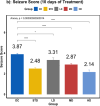Unlocking the Therapeutic Potential: Sitagliptin's Multifaceted Approach in Drug-Resistant Epilepsy through a Novel Mechanism Inhibiting Protein Kinase C-γ and a Long-Term Potentiation Pathway
- PMID: 38898950
- PMCID: PMC11184596
- DOI: 10.1021/acsptsci.4c00073
Unlocking the Therapeutic Potential: Sitagliptin's Multifaceted Approach in Drug-Resistant Epilepsy through a Novel Mechanism Inhibiting Protein Kinase C-γ and a Long-Term Potentiation Pathway
Abstract
Drug-resistant epilepsy is a prominent challenge in chronic neurological disorders. Valproate, commonly used to treat epilepsy, can fail due to various side effects and interactions, necessitating the exploration of alternative treatments. Our study primarily investigated sitagliptin's potential as a therapeutic agent for drug-resistant epilepsy. Employing computational modeling and enzyme assay testing, three lead compounds, emixustat, sitagliptin, and distigmine bromide, were evaluated against the target enzyme protein kinase C-γ. In vivo, experiments on a pentylenetetrazolium-induced lamotrigine-resistant epilepsy model were conducted to test sitagliptin's antiseizure effects, compared with the standard phenobarbital treatment. Emixustat and sitagliptin showcased strong inhibitory properties, while distigmine bromide was less effective in the enzyme assay. Mechanistic insights revealed sitagliptin's ability to modulate the seizure grade and first myoclonic jerk latency via oxidative stress markers, like reduced glutathione and glutathione peroxidase emphasizing its antioxidative role in epilepsy. Additionally, it demonstrated anti-inflammatory effects by significantly reducing proinflammatory markers interleukin-1β and interleukin-6. The modulation of key genes of the long-term potentiation pathway, particularly protein kinase C-γ and metabotropic glutamate receptor 5, was evident through mRNA expression levels. Finally, sitagliptin showed potential neuroprotective properties, limiting pentylenetetrazolium-induced neuronal loss in the hippocampal region. Collectively, our findings suggest sitagliptin's multidimensional therapeutic potential for drug-resistant epilepsy specifically via a long-term potentiation pathway by inhibiting protein kinase C-γ.
© 2024 American Chemical Society.
Conflict of interest statement
The authors declare no competing financial interest.
Figures





Similar articles
-
In Vivo and Computational Studies on Sitagliptin's Neuroprotective Role in Type 2 Diabetes Mellitus: Implications for Alzheimer's Disease.Brain Sci. 2024 Nov 26;14(12):1191. doi: 10.3390/brainsci14121191. Brain Sci. 2024. PMID: 39766390 Free PMC article.
-
Evaluation of the Therapeutic Potential of DPP4 Inhibitor in Upper Tract Urothelial Carcinoma Cells.Anticancer Res. 2025 Mar;45(3):1001-1013. doi: 10.21873/anticanres.17487. Anticancer Res. 2025. PMID: 40037857
-
Sitagliptin's renoprotective effect in a diabetic nephropathy model in rats: The potential role of PI3K/AKT pathway.Fundam Clin Pharmacol. 2022 Apr;36(2):324-337. doi: 10.1111/fcp.12736. Epub 2021 Nov 11. Fundam Clin Pharmacol. 2022. PMID: 34735026
-
Pharmacological and therapeutic properties of valproate: a summary after 35 years of clinical experience.CNS Drugs. 2002;16(10):695-714. doi: 10.2165/00023210-200216100-00004. CNS Drugs. 2002. PMID: 12269862 Review.
-
Glutamate receptor antibodies in neurological diseases: anti-AMPA-GluR3 antibodies, anti-NMDA-NR1 antibodies, anti-NMDA-NR2A/B antibodies, anti-mGluR1 antibodies or anti-mGluR5 antibodies are present in subpopulations of patients with either: epilepsy, encephalitis, cerebellar ataxia, systemic lupus erythematosus (SLE) and neuropsychiatric SLE, Sjogren's syndrome, schizophrenia, mania or stroke. These autoimmune anti-glutamate receptor antibodies can bind neurons in few brain regions, activate glutamate receptors, decrease glutamate receptor's expression, impair glutamate-induced signaling and function, activate blood brain barrier endothelial cells, kill neurons, damage the brain, induce behavioral/psychiatric/cognitive abnormalities and ataxia in animal models, and can be removed or silenced in some patients by immunotherapy.J Neural Transm (Vienna). 2014 Aug;121(8):1029-75. doi: 10.1007/s00702-014-1193-3. Epub 2014 Aug 1. J Neural Transm (Vienna). 2014. PMID: 25081016 Review.
References
-
- Fiest K. M.; Sauro K. M.; Wiebe S.; Patten S. B.; Kwon C.-S.; Dykeman J.; Pringsheim T.; Lorenzetti D. L.; Jetté N. Prevalence and Incidence of Epilepsy: A Systematic Review and Meta-Analysis of International Studies. Neurology 2017, 88 (3), 296–303. 10.1212/WNL.0000000000003509. - DOI - PMC - PubMed
-
- Kwan P.; Arzimanoglou A.; Berg A. T.; Brodie M. J.; Allen Hauser W.; Mathern G.; Moshé S. L.; Perucca E.; Wiebe S.; French J. Definition of Drug Resistant Epilepsy: Consensus Proposal by the Ad Hoc Task Force of the ILAE Commission on Therapeutic Strategies: Definition of Drug Resistant Epilepsy. Epilepsia 2010, 51 (6), 1069–1077. 10.1111/j.1528-1167.2009.02397.x. - DOI - PubMed
LinkOut - more resources
Full Text Sources
